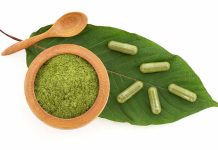Kratom is still a new drug in the United States. However, many Asian countries have used the leaves of the Mitragyna speciose Korth plant for centuries to treat a wide array of medicinal problems. Many individuals turn to kratom to reach a high that usually achieved using opiates and opium-based drugs. However, depending on the purity of this botanical Mitragyna speciosa, the kratom high effects can vary for that of a stimulant to a depressant. The risk of side effects is substantial while under the influence of the drug.
The results of a low-dose kratom high can last for anywhere from ten minutes to an hour, but a high-dose of the medication causes a high that can last for up to five hours.
Users who start to experience unpleasant effects after using kratom should get up and move around, hydrate, sniff black pepper to calm themselves, and try to sleep it off. However, if the user is overly agitated and bombarded with side effects, then they should seek immediate medical aid.
The Kratom High Effects
The high kratom euphoric effects vary among users and dosage. Some users may experience a pleasant sensation, but others become agitated and anxious.
Low Dose Kratom Effects
Typically, a low dose of kratom hovers at around 1 to 5 grams according to the American Drug Addiction Centers. The effects of a kratom low dose high include:
- Euphoria/well-being
- Ample energy
- A feeling of being hyper alert
- Increased libido
- Elevated social behavior
- Decreased appetite
- Pain relief
- Warmth
- Tingling
High Dose Kratom Effects
A high dose of kratom ranges from 5 to 15 grams. The European Monitoring Centre for Drugs and Drug Addiction (EMCDDA) reports that the effects of a high kratom dosage are like those experienced from consuming alcohol. The results include:
- Analgesia (pain reduction)
- Euphoria/well-being
- Drowsiness
- Dreamlike mental state
- Cough suppression
- Warmth
- Tingling
- Decreased appetite
- Heightened sexual drive
Kratom Euphoric Effects
In the journal, ‘Psychoactive Drugs,’ author Marc Swogger wrote about the kratom euphoric effects, “The most prominent theme (30.4%) was a sense of well-being that extended in a degree to euphoria, especially at higher doses. Numerous individuals described this effect as like that of opiates.” The study went on to state, “In sum, our findings suggest that the subjective effects of kratom are generally mild and pleasant, with some important negative physical side-effects, including what appears to be a mild (i.e., relative to opiates) dependence syndrome.”
How to Come Down from Kratom High Effects?
Many individuals will want to come down from the high effect of ingesting kratom quickly. Unfortunately, it typically just takes time. However, there are a few things that you can try to minimize the plant’s effects.
• Hydrate with water
• Sleep
• Sniff black pepper to achieve an energized reaction. This is especially beneficial if the strain of kratom has an opiate-like effect.
The Side Effects of Kratom
Some people suffer unpleasant side effects from kratom use. Often it has to do with the individuals unique biology or the purity of the kratom. However, many side effects reported are less-than-desirable.
- Edginess
- A paranoia that varies from mild to extreme
- Extreme nervousness
- Lethargy
- Vomiting (can be severe and prolonged)
- Nausea (can be severe and prolonged)
- Sweating
- Racing heartbeat
- Itching
- Aggression
- Constipation
- Delusions
- Respiratory depression
- Tremors
- Combative/antagonistic behavior
- Psychotic episodes
- Hallucinations
- Addiction
Is Kratom Addictive?
Users can form an addiction to kratom that is like that experienced by opioid users. Over time, the user develops a compulsive need to use the drug continuously. The habit eventually starts to control the individual’s life. The withdrawal symptoms are often remarkably like those experienced by opioid users or individuals addicted to prescription narcotics.
Prolonged use can cause the following in some users:
- Loss of sexual desire
- Loss of weight
- Darkening of skin on the face
- Constant cravings that drive one to use more of the drug
Withdrawal From Kratom
Many individuals become addicted to Mitragyna and must contend with withdrawals. The intensity of the withdrawals is dependent on the user’s dosage and the length of time that they have been using the drug. Individuals who regularly take high doses suffer more intense withdrawal side effects when they cease using the drug. Many individuals have a challenging time getting clean and coping with the physical withdrawal symptoms.
Withdrawal starts within 6-12 hours of the last dose and begins to peak within 2-3 days. The total time-frame for withdrawal is usually lasting 5 to 10 days total. However, the mental craving can last much longer. Relapse is quite common
Common symptoms of withdrawal include:
- Diarrhea
- A runny nose
- Extreme mood swings
- Jerking of the hands, arms, and legs
- Joint and bone pain
- Extreme hostility
- Confusion
- Hallucinations
- Seizures
- Panic attacks
- High blood pressure
- Depression
- Insomnia and sleep disorders
- Intense cravings
- Irritability
- Muscle and joint pain
- Nausea and vomiting
- Profuse sweating
Overdose Risk of Kratom
To date, there has not been a documented death caused by kratom overdose. However, when used in high doses it can cause very unpleasant side effects that can last for hours and force the user to seek immediate medical care.
Common overdose symptoms include:
- Combative or aggressive behavior
- Delusions
- Lethargy
- Severe Nausea
- Uncontrollable Vomiting
- Paranoia
- Respiratory depression
- Seizures and tremors
- Confusion
- Hallucinations
- Extreme hostility
Where does the Mitragyna Speciose Korth Come From?
The evergreen Mitragyna plant is a member of the coffee family. It grows wild throughout Malaysia, Thailand, Myanmar, Borneo, Philippines, and New Guinea. Although a tropical plant, it grows well in many regions of the world.
Kratom High Strains
As with any plants used for medicinal purposes, Selective cultivation of the plant develops certain high kratom strains that hold far more alkaloids than the natural plant.
Here are just a few strains of Mitragyna:
- Bali Kratom: This high kratom strain offers enhanced euphoric effects. Many consider this strain to supply the most opiate-like high.
- Maeng Da: The Maeng Da reduces pain. It also makes the user feel more energized.
- Red Vein Kali: This strain produces a sedative-like effect.
- Green Vein Kali: Stimulating and helps reduce pain.
- Super Indo: Very stimulating with only a reduced euphoric reaction.
Altered High Kratom Strains
The alkaloids pulled from the Mitragyna create a potent strain of kratom.
- Gold Reserve Extract: Prominent levels of plant alkaloids go through an extraction process and then reinjected into the plant material.
- Natural Enhanced True Thai: Extraction pulls 90 percent pure alkaloid from the Thai Kratom and then reinjected into the Green Vein Thai leaf.
- Natural Enhanced White Sumatra: An extraction of at least 90 percent pure alkaloid comes from the White Vein kratom and then remixed to create a high kratom product.
Mitragyna Speciose Korth Use Throughout Asia
Throughout history, the leaves of the Mitragyna speciose Korth have been abused in Asian countries. Indigenous people in Malaysia and Thailand would either chew the leaves or brew them in a tea to boost their energy levels so they could increase productivity on farms or in the labor market. The effects of the plant also helped relieve their physical pain.
Kratom in Thailand
Nowadays, the government of Thailand has labeled the Mitragyna speciose Korth a controlled substance. The plant’s leaves are often combined with cough syrup and Coke, strong tranquilizers, and marijuana to produce a narcotic drink called “4×100.” The concoction has become a favored drug among young Muslims in the region. Throughout the area, it is the third most abused illegal drug, according to a report issued by NBC News.
Kratom in the United States
Before 2012, most people in the United States had never heard of kratom. However, today the drug has become widespread and is sold as a dietary or nutritional supplement. People can find kratom at head shops or smoke shops in the form of a powder or tablet. Throughout North Carolina, New York, Colorado, and a few other states kratom is sold as a drink called ‘ketum’ in nightclubs, and bars.
Legalities of Kratom in the United States
As with so many ‘drugs’ in the United States such as cannabis, the use of kratom is very grey and dictated by state laws. Federally, Mitragyna is still legal, but the government still tries to control the importation of the plant into the country. However, many states are taking steps to ban or regulate the use of Mitragyna.
Currently, these are the laws in some individual states regarding kratom:
- Alabama: As of May 10, 2016, kratom the plant gained the classification of a Schedule 1 controlled substance.
- Arkansas: In February 2016, lawmakers listed the plant as a controlled substance
- California: Kratom is legal throughout the state of California but banned in the city of San Diego.
- Florida: The use of kratom is legal in Florida, except in Sarasota County.
- Illinois: Kratom is legal in Illinois to anyone over 18 but banned in the town of Jerseyville.
- Indiana: Kratom is classified as a synthetic drug, and it is banned.
- New Hampshire: Kratom products are available to anyone over the age of 18.
- Tennessee: Kratom is considered a controlled substance.
- Wisconsin: The law states that the primary alkaloids present in the Mitragyna plant are classified as Schedule 1.
The Drug Enforcement Administration (DEA) and Mitragyna
To date, the United States Drug Enforcement Administration (DEA) has started to work at having kratom listed as a Schedule 1 substance just like heroin. The DEA believes that Mitragyna is addictive and damaging. DEA spokeswoman Katherine Pfaff states that the agency considers it “harmful and dangerous.” Unfortunately, finding that Mitragyna has been used for centuries by indigenous people as a medicinal aid.
Undoubtedly, there are some holistic health benefits that the plant provides to users. If the DEO opts to list Mitragyna as a Schedule 1 drug the medical research being done surrounding the plant will undoubtedly be forced to come to a halt, so the possible health benefits of the natural plant may never be discovered.
Currently, the DEA has opened a public comment period on Mitragyna and its legality at the federal level.
The Dangers of Long-Term Mitragyna Use
The long-term use of Mitragyna is not without dangers. Research shows that the use of the plant can damage the thyroid. When used, the plant appears to suppress the hormones produced by the thyroid which leads to a condition known as hypothyroidism, according to researchers at the Cleveland Clinic Alcohol and Drug Recovery Center in Cleveland, Ohio. It is believed that the alkaloid found naturally in the plant significantly reduces the standard response of the thyroid gland to the thyroid-stimulating hormone, which causes primary hypothyroidism.
The symptoms of hypothyroidism include:
• Fatigue
• Slowed heartbeat
• Depression
• Weight gain
• Sensitivity to cold
• Puffy face
• Elevated blood cholesterol
• Muscle aches
• Pain, stiffness, or swelling around the joints
• Slowed heartbeat
• Impaired memory
Possible Liver Toxicity
Although occasional use of Mitragyna appears to have no adverse effect on the liver when mixed with other drugs such as narcotics the likelihood of liver damage escalates. Some individuals have suffered liver toxicity after the chronic abuse of Mitragyna.
Kratom Opiates High for the Treatment of Narcotic Addiction
Undeniably, the kratom opiates high can be remarkably like that reached from the use of any opioid. The similarities are one of the main reasons that many individuals turn to kratom to help relieve opiate withdrawal symptoms. Research continues into the possible benefit of using kratom not only to treat opioid withdrawals but also as a replacement to many opioid-based painkillers.
Researchers at the Division of Medical Toxicology at the Department of Emergency Medicine at the University of Massachusetts Medical School in Worcester, MA found that kratom does reduce the often severe withdrawal symptoms of opioid addiction. Though users can develop a kratom addiction, the withdrawals from kratom tend to be far less severe than opioids.
The study also investigated the use of kratom as an opioid substitute for a pain reliever. Researchers concluded that the plant-based drug could prove a practical alternative possibility for chronic pain sufferers.
Currently, kratom is still widely available around the world. Undoubtedly, further research needs to be carried out to determine the possible health benefits and high kratom effects.
Unfortunately, if the Mitragyna plant is made illegal in the United States, then research will come to a virtual standstill, and the medical community may never learn the holistic medicinal options of the plant. Ideally, users of kratom should cease abusing the substance and instead explore the plant’s history to determine its natural health benefits.








